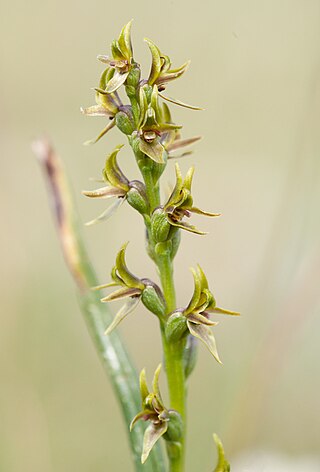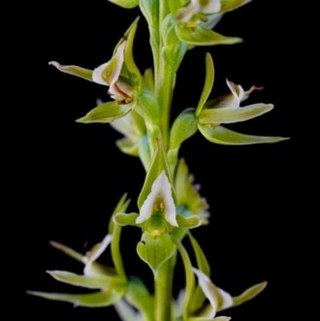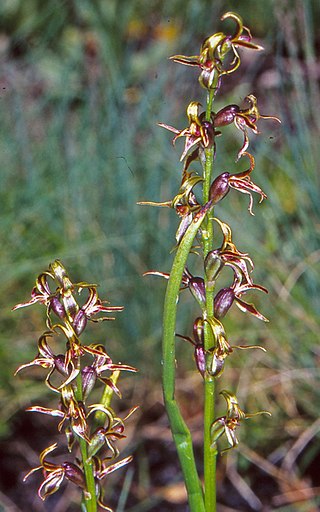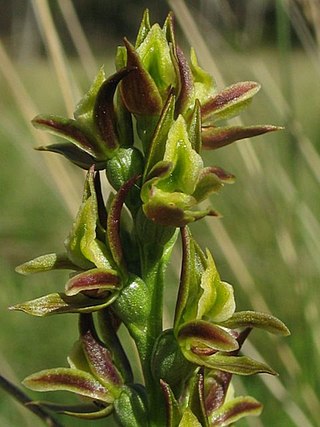Prasophyllum correctum, commonly known as the gaping leek orchid or Bairnsdale leek orchid, is a species of orchid species endemic to a small region in Victoria. It has a single dark green, tube-shaped leaf and up to twenty strongly scented, yellowish-green flowers and is only known from railway reserves near Bairnsdale.

Prasophyllum tadgellianum, commonly known as the alpine leek orchid, is a species of orchid native to the Snowy Mountains and Tasmania. It has a single stiff, erect leaf and up to twenty scented, greenish-brown or reddish-brown flowers crowded on a stout spike.
Prasophyllum australe, commonly known as the southern leek orchid or austral leek orchid, is a species of orchid and is endemic to south-eastern Australia. It has a single tubular, green leaf and up to fifty scented, greenish-brown flowers with red stripes.

Prasophyllum alpestre, commonly known as the mauve leek orchid, is a species of orchid endemic to eastern Australia. It has a single tubular, green leaf and up to twenty five scented, white, purplish and green flowers. It grows in subalpine parts of New South Wales, Victoria and Tasmania.

Prasophyllum brevilabre, commonly known as the short-lip leek orchid, is a species of orchid endemic to south-eastern Australia. It has a single tubular, green leaf and up to thirty small, greenish-brown flowers with a white labellum. The labellum is sharply turned back on itself so that its tip almost reaches its base.

Prasophyllum montanum, commonly known as the mountain leek orchid, is a species of orchid endemic to eastern Australia. It has a single tubular, green leaf and up to fifty scented, greenish to pinkish flowers. It grows in montane ecosystems at altitudes above 1,500 m (5,000 ft).

Prasophyllum sphacelatum, commonly known as the subalpine leek orchid, is a species of orchid endemic to south-eastern Australia. It has a single tubular, dull green leaf and up to eighteen scented, green to brownish flowers with a green to pinkish labellum. It grows in subalpine areas of New South Wales, Victoria and Tasmania.
Prasophyllum campestre, commonly known as the sandplain leek orchid, or inland leek orchid, is a species of orchid endemic to eastern Australia. It has a single tubular, yellowish-green leaf and up to twenty greenish, strongly scented flowers with red, purplish, brown or white marks. It grows in the drier parts of Queensland, New South Wales and Victoria.

Prasophyllum sylvestre, commonly known as the forest leek orchid, is a species of orchid endemic to south-eastern Australia. It has a single tubular, bright green leaf and up to thirty faintly scented, pale green, pink and reddish-brown flowers. It is similar to P. fuscum and P. affine but differs from them, including in the habitat in which they grow.

Prasophyllum odoratum, commonly known as the fragrant leek orchid, Rogers scented leek orchid or sweet leek orchid is a species of orchid endemic to south-eastern Australia. It has a single tubular leaf and up to fifty fragrant green and white flowers with reddish marks.

Prasophyllum lindleyanum, commonly known as the green leek orchid, is a species of orchid endemic to south-eastern Australia. It has a single smooth, tube-shaped leaf and up to twenty scented, greenish flowers with a greenish or white labellum with a pink tinge.

Prasophyllum wilkinsoniorum is a species of orchid endemic to New South Wales. It has a single tubular, bright green leaf and up to forty five scented, dark greenish-brown to brownish-red flowers with a green to pinkish labellum. It grows in grassy places in a restricted area on the Southern Tablelands.

Prasophyllum canaliculatum, commonly known as the channelled leek orchid or summer leek orchid, is a species of orchid endemic to a small area of southern New South Wales. It has a single tubular, bright green leaf and up to twenty five scented, greenish-red or brownish flowers on a flowering stem. It grows in woodland at altitudes around 1,000 m (3,000 ft) where only about two hundred plants survive.

Prasophyllum fuscum, commonly known as the slaty leek orchid or tawny leek orchid, is a species of orchid endemic to a small region of New South Wales. It has a single tubular green leaf and up to thirty greenish brown to reddish brown flowers. There is debate about the taxonomy of the species with some authorities considering Prasophyllum uroglossum as a separate species. Only about twenty five plants are known to survive in south-western Sydney.
Prasophyllum giganteum, commonly known as the bronze leek orchid, is a species of orchid endemic to the south-west of Western Australia. It is a tall, fragrant leek orchid with a single smooth, tubular leaf and up to fifty or more green and pinkish-purple flowers with a frilly labellum.
Prasophyllum hectori, commonly known as the swamp leek orchid, is a species of orchid endemic to New Zealand. It has a single tubular, dark green leaf and up to eighty scented, yellow-green flowers with red or brown marking. It is similar to P. colensoi, the only other species of Prasophyllum found in New Zealand, but is distinguished from it by its larger size, larger number of flowers and swampy habitat.

Prasophyllum patens, commonly known as the broad-lipped leek orchid or sandstone leek orchid, is a species of orchid endemic to the Sydney region of New South Wales. It has a single tubular green leaf and up to thirty green to greenish-brown, lemon-scented flowers with a white labellum.
Prasophyllum rostratum, commonly known as the slaty leek orchid, is a species of orchid endemic to Tasmania. It has a single tubular leaf and up to twenty five well-spaced, greenish-brown flowers. It is similar to P. pyriforme from mainland Australia but lacks that species' white to pinkish labellum.
Prasophyllum truncatum, commonly known as the truncate leek orchid, is a species of orchid endemic to Tasmania. It has a single tubular, dark green leaf and up to twenty whitish flowers with purplish and greenish-brown markings. It is a late-flowering leek orchid and its flowering is stimulated by earlier fire.
Prasophyllum pictum is a species of orchid endemic to New South Wales. It has a single tubular, shiny dark green leaf and up to twenty two scented brown, pink, purple and white flowers. It is only known from three subpopulations on the Northern Tablelands.













